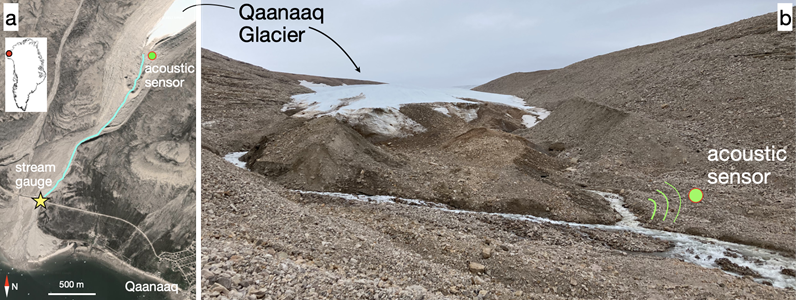The method, published in the journal Geophysical Research Letters, is not only ~100 times cheaper than the most novel methods but also non-invasive, quick and easily deployable, and can become a tool for long-term glacier monitoring.
Previous research, including that from the team, linked inaudible (infrasound) signals to glacial runoffs, noting a daily variation in the recordings and a peak during the summer. It was hypothesized that these signals might be generated by the radiation of air-pressure waves from the glacial runoff. Consequently, it was suggested that glacier discharge could be measured by analyzing the audible sounds that are also emitted by melting glaciers.
The team of researchers conducted the first near-source study at Qaanaaq Glacier, Greenland, that showed acoustic noise levels scale with proglacial discharge, with an easy-to-detect, audible diurnal pattern. “The ambient sound could be described as a continuous hum of roaring water, which would be familiar to anyone who walked near a white water,” said team leader Evgeny Podolskiy.

Photo: Adapted from Evgeny A. Podolskiy, Takuro Imazu, and Shin Sugiyama. Geophysical Research Letters. April 26, 2023
For recording the ambient soundscape, the team deployed a commercially available bird-song recorder near the terminus of the Qaanaaq Glacier. “We estimated the proglacial discharge by water-depth and flow-speed measurements, which were collected at the intersectional site of the proglacial stream and the road between Qaanaaq and the local airport. The acoustic data was analyzed and the result was then cross-correlated with the discharge in order to single out a frequency band that was the best proxy for the proglacial stream,” explains Podolskiy.
The study demonstrated that audible acoustic signals can be used for sensing glacio-hydrological variations remotely and continuously. The method reduces the risk of instrument loss and does not require avant-garde data processing techniques. Although it does not provide the high spatial resolution of fiber-optic tools that are currently used, it breaks new ground in terms of affordability and overall simplicity. This method can be used to set up early-warning systems to timely detect events like glacier lake outbursts and help mitigate glacial flooding events.
Read the original press release on Hokkaido University’s website. Read the full paper: Acoustic Sensing of Glacial Discharge in Greenland.
